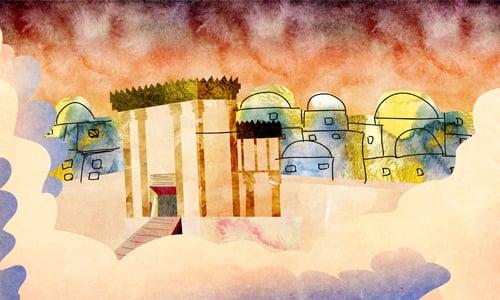Located to the east of Jerusalem’s historic Old City, the Temple Mount, once home to both Holy Temples, is the holiest place on earth. Although the Temple no longer stands, throughout the millennia Jews have gathered at the wall supporting the mountain’s western flank (“the Western Wall”) to pray.
The Temple Mount is a portal—the place where the veil separating earth from the spiritual plane is most translucent. Our sages tell us that it is the conduit through which all prayers ascend to heaven.1
The Origins of the Temple Mount
The holiness of the Temple Mount begins with the creation of humankind. According to tradition, it was from there that G‑d plucked the dirt to form the body of Adam, the first mortal.2 The sanctity of the site was thus etched into its dirt from the first week of existence.
Two thousand years later, G‑d sent Abraham there to sacrifice his son. G‑d commanded him to travel “to the mountain that I will show you.”3 Which mountain was that? The Temple Mount.
At that point, scripture referred to it by the name Mount Moriah.4
The first person to truly express the majesty of the Temple Mount was Jacob. On his journey to Charan, he stopped at Mount Moriah for a night. There, he dreamt of a ladder ascending to heaven, with angels traveling down and up it. When he awoke, he realized where he had slept. “This place,” he intoned, “is a portal to heaven.”5
King David and the Temple Mount
Then, 700 years later, King David shone the spotlight on it once again.
For six years, King David ruled only the Kingdom of Judah, based in Hebron. Saul’s son, Ish Bosheth, ruled the remainder of Israel. After six years of rivalry, Abner, who had supported Ish Bosheth, switched sides and pushed for David to take rulership of the entire land. His wish was soon realized when King David reunited the kingdom after the death of Ish Boshet.
In a bid to repair the fractured population, David decided to move his palace to a more central city. He chose Jerusalem, on the border of the regions of Judah and Benjamin.
Then, at the height of a raging epidemic, King David met an angel on the threshing floor of a man called Aravnah the Jebusite, which was located on the future Temple Mount.6 The angel commanded him to erect an altar at that location and offer sacrifices. Those offerings would end the plague.
King David purchased the threshing floor from Aravnah for 600 gold shekels.7 He built an altar and offered up sacrifices, and indeed, the plague stopped.8
David designated the location of that altar as the future site of the Temple.9
The Temples
King David’s son Solomon built the first Temple. For the next 410 years, it adorned the Temple Mount. The mountain became the center of spiritual, political, and social life in Israel. It was there that pilgrims would gather three times each year. It was there that the people would bring offerings for atonement, gratitude, and to celebrate milestones. From there, the highest court would teach Torah to the nation.
But after 410 years, the Babylonians came and destroyed it. For 70 years, the Temple Mount lay in ruins. It remained desolate until a group of exiles ascended from Babylonia, headed by Ezra, and rebuilt the Temple.
The poor group led by Ezra did the best they could to make it a beautiful building with whatever resources they could scrounge. But in comparison to the first Temple, it was a pale reflection.10 Over the centuries, the Temple fell further and further into disrepair.
That is when Herod took it upon himself to repair the Temple and the Temple Mount. In one of the largest construction projects of the century, Herod hauled in tons of dirt, built retaining walls, and reshaped the Temple Mount entirely. He doubled the area11 of what was originally a natural mountain, turning it into a massive plaza, 500 cubits square.12
The remodeled Temple was unparalleled in glory.13 It crowned Jerusalem for nearly 100 years, until the Second Temple’s destruction at the hands of the Roman Empire.
Read: 9 Facts About the Holy Temples
One area of the retaining wall holding up the gargantuan square survived the destruction and later became known as the Western Wall.
Read: The Western Wall (Kotel)
Its Names
The mountain that would later house the Temple was originally called Mount Moriah. As with all names found in the Torah, it bears a special meaning. The name pointed to its future. Moriah comes from the word “hora’a”, instruction, referring to the fact that the Sanhedrin, the Jewish High Court, was situated on the Temple Mount.14 Alternatively, Moriah stems from the Hebrew word for myrrh (mor), a reference to the incense brought daily in the Holy Temple.15
After the Binding of Isaac, Abraham renamed it Mount Ado-nai Yireh, meaning “G‑d will be seen,” hinting that in the future, G‑d would rest His Divine Presence there.16
Following in the tradition of his grandfather, Jacob also renamed the location after experiencing his vision. The name he gave, Beth E-l, “house of G‑d,” was likewise a nod to the future Temple.17
Its Sanctity
The moment David designated the mountain to be the site of the future Temples, it became holy. That holiness remains embedded eternally, even now when the Temples are no longer standing.18
That holiness mandates a certain decorum. We may not enter the Temple Mount with a staff, money pouch, or dusty feet. The Temple Mount may not be used as a shortcut. One may not spit there.19 Most importantly, we cannot go there when we are ritually impure. Nowadays, due to the lack of a Red Heifer, we are all presumed to be impure. So, until the coming of Moshiach who will prepare a Red Heifer for us, we are all barred from entering the Temple Mount.
Read: 15 Facts About Moshiach











Join the Discussion